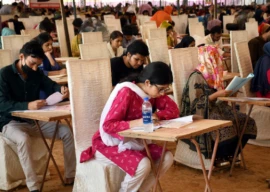
This was revealed by a country-wide survey of government primary schools for girls by the Free and Fair Election Network’s (FAFEN) Education Monitor division.
The survey monitored 137 primary schools for girls in 87 districts across the country. It was revealed that sanitary workers were not present in 72 per cent of the monitored schools, while 49 per cent of the monitored schools did not provide clean drinking water facilities to children, putting them at risk of water-borne diseases.
Transparency surfaced as a major issue during the survey as 20 schools did not provide information about the sanctioned teaching posts, while 66 refused to provide information about their non-teaching staff. Information on teacher and student attendance, on the day of the FAFEN observer’s visit, was also withheld by some schools. The survey revealed that seven per cent of the total sanctioned teaching posts and 13 per cent of the sanctioned non-teaching posts in these schools were lying vacant. The highest number of unoccupied teaching and non-teaching posts were observed in Sindh, which were nine per cent and 22 per cent respectively.
Nationwide, the average number of students per teacher came out to be 34. The highest number of student per teacher ratio was observed in Fata, where one teacher was appointed to 45 students on average. The lowest student per teacher ratio was observed in Sindh, where one teacher was expected to teach 27 students.
“It is difficult to meet the schools’ every requirement within a limited budged,” said the Education Ministry’s Joint Secretary Sheghan Sharif Malik while talking to The Express Tribune. Though some development budget has been cut, recurring expenditures are being provided to every school, he said. “The ministry has taken measures to improve the quality of the schools but it will take time before all targets are met.”
The joint secretary said that the ministry is getting technical assistance from Japan International Cooperation Agency, Canadian International Development Agency, German Technical Cooperation and the UK’s Department for International Development for the capacity building of teachers. “As the ministry is expected to be devolved to the provinces, it will focus on these issues once the decision of its fate is made,” he added.
A teacher of a primary school in the ‘kachi abadi’ of sector G-8 said that his school lacks basic facilities including provision of clean drinking water. He alleged that the government discriminates between schools of developed and underdeveloped localities by focusing expenditure on schools in developed areas. “The government should provide the same facilities to schools in kachi abadis as it does to the model schools of Islamabad,” he added.
Despite 82 oversight visits by government and elected officials to the monitored schools, from September to November 2010, infrastructural issues and vacant teaching or non-teaching posts were observed in almost all monitored schools.
A total of 59 schools were monitored in 32 districts of Punjab, 33 in 23 districts of Khyber Pakhtoonkhwa (K-P), eight in 23 districts of Balochistan, 35 in 22 districts of Sindh and two schools in 22 districts of Fata. The infrastructural situation of girls’ primary schools was better in K-P when compared to the schools in other regions, the report added.
FAFEN’s survey also revealed that 27 of the 137 schools were not housed in proper buildings. In addition, 24 per cent of the monitored schools did not have playgrounds, while 46 per cent lacked staff rooms for teachers. Moreover, 32 per cent of the schools did not have peons and 29 per cent had no security arrangements.
Published in The Express Tribune, February 8th, 2011.

1726117332-0/Megan-Thee-Stallion-(1)1726117332-0-165x106.webp)








1724319076-0/Untitled-design-(5)1724319076-0-270x192.webp)
1735025557-0/Untitled-(96)1735025557-0-270x192.webp)











COMMENTS
Comments are moderated and generally will be posted if they are on-topic and not abusive.
For more information, please see our Comments FAQ